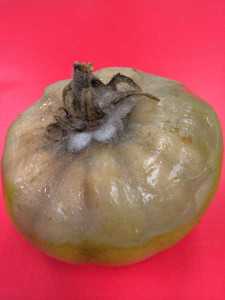Managing Botrytis And Sclerotinia White Mold In High Tunnel And Greenhouse Tomatoes
Both Botrytis grey mold and Sclerotinia white mold can cause serious problems in high tunnel tomatoes. They are favored by cool temperatures and high relative humidity. Even if you have warm days, cool nights can encourage development of these diseases.

Botrytis ghost spot of tomato. Photo by Sally Miller.
Botrytis causes several types of symptoms on tomatoes, including blighting of leaves and stems and other green tissue, and soft rot and ghost spots on fruit. The ghost spots appear when Botrytis infects the fruit but the disease does not progress. Sclerotinia white mold often attacks tomatoes at the base of the stem in high tunnels, killing the tissues and causing the plants to wilt and die. Eventually hard black, round-irregularly shaped Sclerotia can be observed inside or outside the stem.
Several fungicides are available for use against fungal diseases in high tunnels and greenhouses. According to the Ohio Department of Agriculture, regulations pertaining to greenhouses also apply to high tunnels. The directions for use on the pesticide labels must be followed. Restricted-use pesticides can only be used by Certified Pesticide Applicators with the greenhouse certification on their applicator license. Restricted-use pesticides are identified prominently on the label.
Pesticides that are not restricted-use and are labeled for tomatoes but without specific greenhouse use directions may be used unless greenhouse use is expressly prohibited on the label. Thus, a specific label for greenhouse use is not required; but the label must be read carefully to be certain the greenhouse use is not restricted.

Botrytis grey mold of tomato. Photo by Sally Miller.
For more information about fungicide usage allowances in high tunnels and greenhouses, please contact the Ohio Department of Agriculture. Information on insecticide and fungicide labeling for greenhouse use is included in the Midwest Vegetable Production Guide for Commercial Growers.
Scala (Bayer CropScience) and Fontelis (DuPont) are labeled for Botrytis and white mold management in greenhouse tomatoes. For other diseases, certain copper products, Tanos (DuPont), and Manzate (Dupont), Dithane (Dow), and other Ethylenebisdithiocarbamates (EBDC) fungicides may be used in greenhouse or high tunnel tomatoes. The fungicides Curzate (DuPont), Gavel (Gowan), Previcur Flex (Bayer CropScience) and Ranman (FMC) may be used for late blight management. Some fungicides commonly used in open field tomato production, such as Bravo Weather Stik (Syngenta), Quadris (Syngenta), Cabrio (BASF) and Endura (BASF), are not allowed in greenhouse or high tunnel systems.
Source: By Sally Miller, Department of Plant Pathology, OSU, OARDC, OSU Vegnet news release









